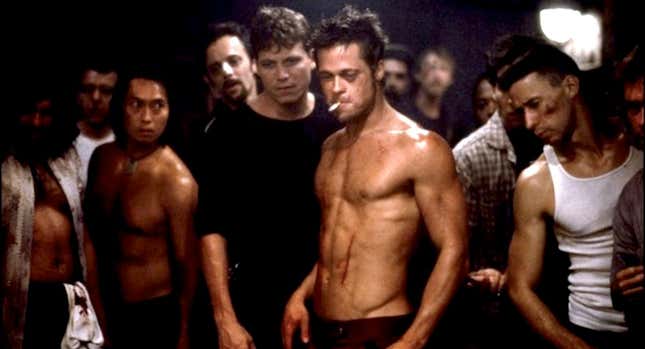Project Mayhem: Two Fight Club Virgins Watch the 1999 Cult Classic for the First Time
EntertainmentMovies
Screenshot: Fight Club (1999)/20th Century Fox
It’s one of the most often repeated movie lines of all time: “The first rule of Fight Club is you don’t talk about fight club. The second rule of Fight Club is you don’t talk about fight club.” Twenty-two years on, it is time to talk about Fight Club.
David Fincher’s 1999 cult classic film, an adaptation of Chuck Palahniuk’s sardonic novel of the same name, is unavoidable, even for those who haven’t seen it—like my colleague Rich Juzwiak and myself, before last week. Part of the plot has infiltrated some collective understanding of pop culture: the name evokes the image of an underground bare-knuckle boxing ring, of barbarity, of stifled sexuality, and of celebration. Despite the cardinal rule, people fucking love to talk about Fight Club.
In 1999, that might’ve come as a surprise: Fight Club was a box office flop. The film grossed $37 million domestically off a $63 million budget, Indiewire reports, perhaps emblematic of its genius: Fight Club was misunderstood at the time, though it has stood the test of it.
Fight Club is layered, much more involved than the appropriative homoeroticism and Gen-X apathy-turned-violence of its marketing. It is a critique of capitalism, of masculinity, of apathy. Starring Edward Norton as “The Narrator,” an insomniac “30-year-old child,” as he refers to himself, an automobile recall specialist unfulfilled by his white-collar, hyper-materialistic life and Brad Pitt as “Tyler Durden,” an impetuous soap salesman, the film truly begins when the pair start a Fight Club—offering a frightening, boys-only release. What follows is, well, what follows—a great film worth watching. –Maria Sherman
MARIA: Prior to last night, Fight Club was a pop culture blind spot—consider it my version of binging the entire Sopranos series over quarantine—and what a space to fill! I’ve never read a Chuck Palahniuk book. I knew it was directed by David Fincher; I’ve seen and quite possibly once enjoyed 2010’s The Social Network and 2014’s Gone Girl. I’ve committed the first two rules of Fight Club to memory, probably after watching 30 Rock’s parody, where well-to-do housewives pummel each other to take the edge off. (More embarrassingly, as a student of third-wave emo/Hot Topic-branded mall pop-punk, there’s a Taking Back Sunday music video where the Long Island band recreates scenes from the movie. I always thought it was stupid, now I see it simply lacks the disaffection of “The Narrator.”) I also pre-judged Fight Club as violent, braggadocious nonsense (much like third-wave emo), assuming it was a movie specifically engineered to appeal to, I don’t know, freshman film students and men with an exaggerated sense of machismo. I was wrong. I judged the book by its cover. Forgive me Fight Club fathers, for I have sinned. If someone told me a vampiric Helena Bonham Carter was in this, rocking stellar goth-y thrift store fit after stellar goth-y thrift store fit, I’m confident I would’ve watched it sooner.
I think I… liked this movie? And in a way where I was able to divorce my appreciation for it from our correct political moment—there are obvious and potentially lazy parallels to be made between Project Mayhem and far-right, incel groups, but overall—great film? And Mr. Robot totally ripped it off, someone call Sam Esmail stat.
Anyway, this is Flashback Film Friends, and I want to make a conclusive judgment call. I think this movie is good, but too long. Or maybe my brain is mush. Perhaps from getting into too many fights.
Rich, did you enjoy rewatching Fight Club? When was the last time you saw it?
-

-

-

-

-

-

-

-

-

-

-

-

-

-

-

-

-

-

-

-

-

-

-

-

-

-

-

-

-

-

-

-

-

-

-

-

-

-

-

-











































